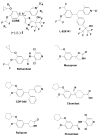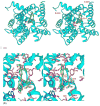Enantiomer discrimination illustrated by the high resolution crystal structures of type 4 phosphodiesterase
- PMID: 16539372
- PMCID: PMC2527038
- DOI: 10.1021/jm051273d
Enantiomer discrimination illustrated by the high resolution crystal structures of type 4 phosphodiesterase
Abstract
Type 4 phosphodiesterase (PDE4) inhibitors are emerging as new treatments for a number of disorders including asthma and chronic obstructive pulmonary disease. Here we report the biochemical characterization on the second generation inhibitor (+)-1 (L-, IC50=0.4 nM) and its enantiomer (-)-1 (L-, IC50=43 nM) and their cocrystal structures with PDE4D at 2.0 A resolution. Despite the 107-fold affinity difference, both enantiomers interact with the same sets of residues in the rigid active site. The weaker (-)-1 adopts an unfavorable conformation to preserve the pivotal interactions between the Mg-bound waters and the N-oxide of pyridine. These structures support a model in which inhibitors are anchored by the invariant glutamine at one end and the metal-pocket residues at another end. This model provides explanations for most of the observed structure-activity relationship and the metal ion dependency of the catechol-ether based inhibitors and should facilitate their further design.
Figures




Similar articles
-
Crystal structure of phosphodiesterase 4D and inhibitor complex(1).FEBS Lett. 2002 Oct 23;530(1-3):53-8. doi: 10.1016/s0014-5793(02)03396-3. FEBS Lett. 2002. PMID: 12387865
-
Multiple elements jointly determine inhibitor selectivity of cyclic nucleotide phosphodiesterases 4 and 7.J Biol Chem. 2005 Sep 2;280(35):30949-55. doi: 10.1074/jbc.M504398200. Epub 2005 Jul 1. J Biol Chem. 2005. PMID: 15994308
-
Insight into binding of phosphodiesterase-9A selective inhibitors by crystal structures and mutagenesis.J Med Chem. 2010 Feb 25;53(4):1726-31. doi: 10.1021/jm901519f. J Med Chem. 2010. PMID: 20121115 Free PMC article.
-
Implications of PDE4 structure on inhibitor selectivity across PDE families.Int J Impot Res. 2004 Jun;16 Suppl 1:S24-7. doi: 10.1038/sj.ijir.3901211. Int J Impot Res. 2004. PMID: 15224132 Review.
-
Phosphodiesterase 4 inhibitors for the treatment of asthma and COPD.Curr Med Chem. 2006;13(27):3253-62. doi: 10.2174/092986706778773040. Curr Med Chem. 2006. PMID: 17168849 Review.
Cited by
-
Advances in targeting cyclic nucleotide phosphodiesterases.Nat Rev Drug Discov. 2014 Apr;13(4):290-314. doi: 10.1038/nrd4228. Nat Rev Drug Discov. 2014. PMID: 24687066 Free PMC article. Review.
-
Kinetic and structural studies of phosphodiesterase-8A and implication on the inhibitor selectivity.Biochemistry. 2008 Dec 2;47(48):12760-8. doi: 10.1021/bi801487x. Biochemistry. 2008. PMID: 18983167 Free PMC article.
-
Chemical informatics uncovers a new role for moexipril as a novel inhibitor of cAMP phosphodiesterase-4 (PDE4).Biochem Pharmacol. 2013 May 1;85(9):1297-305. doi: 10.1016/j.bcp.2013.02.026. Epub 2013 Mar 5. Biochem Pharmacol. 2013. PMID: 23473803 Free PMC article.
References
-
- Soderling SH, Beavo JA. Regulation of cAMP and cGMP signaling: new phosphodiesterases and new functions. Curr Opin Cell Biol. 2000;12:174–179. - PubMed
-
- Conti M, Richter W, Mehats C, Livera G, Park JY, Jin C. Cyclic AMP-specific PDE4 phosphodiesterases as critical components of cyclic AMP signaling. J Biol Chem. 2003;278:5493–5496. - PubMed
-
- Maurice DH, Palmer D, Tilley DG, Dunkerley HA, Netherton SJ, Raymond DR, Elbatarny HS, Jimmo SL. Cyclic nucleotide phosphodiesterase activity, expression, and targeting in cells of the cardiovascular system. Mol Pharmacol. 2003;64:533–546. - PubMed
-
- Goraya TA, Cooper DM. Ca2+-calmodulin-dependent phosphodiesterase (PDE1): current perspectives. Cell Signal. 2005;17:789–797. - PubMed
Publication types
MeSH terms
Substances
Associated data
- Actions
- Actions
Grants and funding
LinkOut - more resources
Full Text Sources
Chemical Information
Molecular Biology Databases

